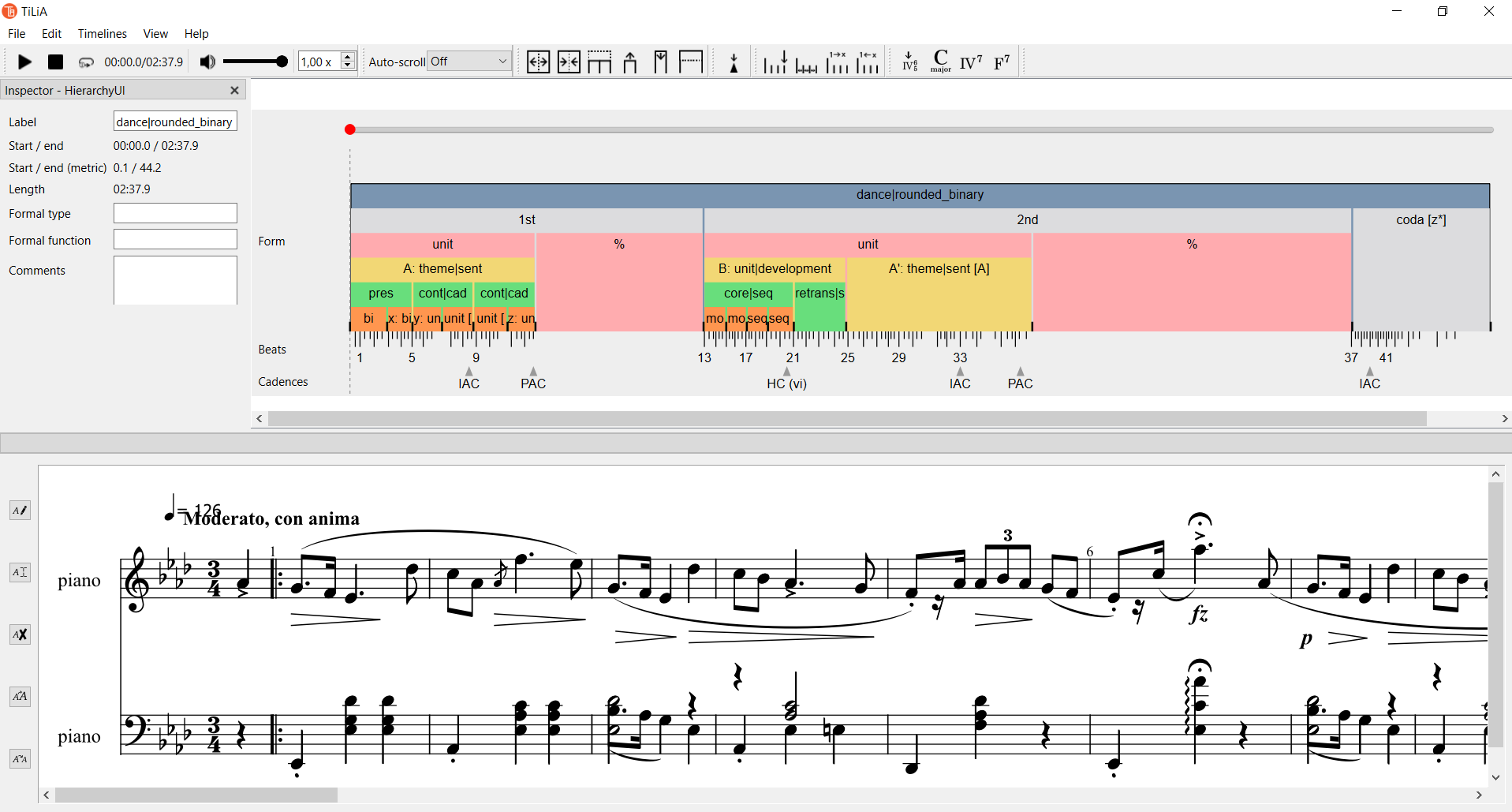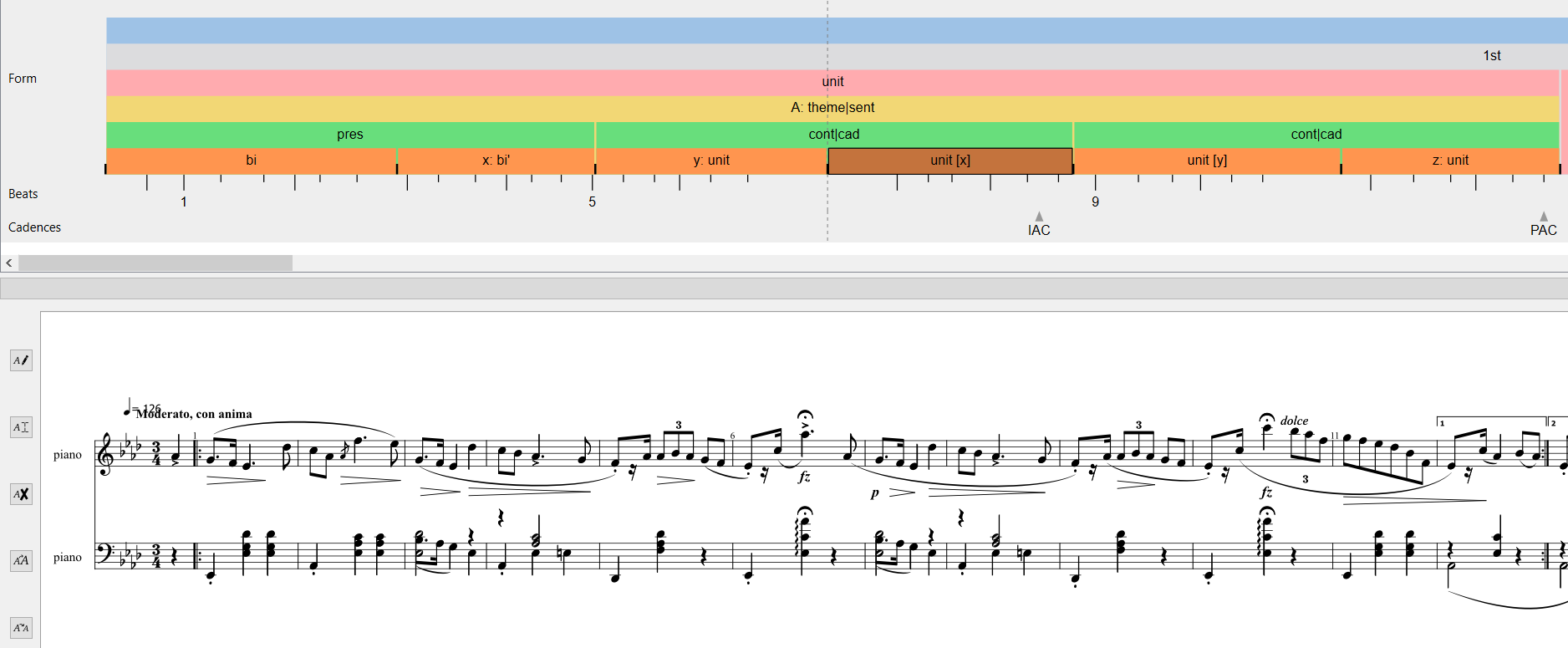Principles
This section uses Frédéric Chopin: Mazurka in A-flat major, op. 24, 3 (1835) (see: Examples) to explain the use of TiLiA for creating form annotations.
TiLiA Layout

Each TiLiA File is made up of the following timeline elements:
- A free audio recording of the piece, imported locally
- One or more Hierarchy Timelines for the form analysis itself
- A Beat Timeline
- A Marker timelines for Cadences
- Optional: Harmony Timeline (Import of DCML harmony analyses is under development)
- Optional: Marker Timeline for additional notes and comments
- A Score timeline (MusicXML) aligned with the recording
Using Hierarchy Timelines to encode a form analysis
The hierarchy timeline is the most important part of the analysis, as it represents the relationships between different timespans of the music. The following is a minimal ruleset that ensures consistency between annotations.
The principle of having a top level (“root”) spanning the entire piece
Every hierarchical form analysis must have a top level, spanning across the entire annotated section uninterrupted.
This analysis looks complete on the surface, but is missing the unifying label:

These segments should be grouped up one more time, as above.
Labeling of the top level: The part before the pipe symbol may be used to identify the music in a larger context, e.g. as a first movement of a sonata cycle. While the part after the symbol indicates what kind of form the piece as a whole has. If the piece is understood to be independent of any larger context, you can use generic names such as “piece”, “track”, “song” etc. The Chopin example was titled in this way, which indicates the interpretation that opus 24 is a rather loosely connected set of individual pieces, rather than a cycle expected to be heard in sequence.
Other Examples:
mov2|minuet_and_trio- The third movement of a sonata cycle, realized as a minuet with trio.track04|strophic- The fourth track in a rock album, which happens to be written in a strophic form (no chorus).exp|continuous- here the analysis only deals with the exposition section of a movement, so that is the head level. The exposition is continuous because it does not have a medial caesura or clear secondary theme zone.
The principle of locating ideas/sub-phrases at the bottom level
The lowest level of the hierarchy should correspond to individual musical ideas. For example in a Caplinian Style: bi (basic idea), ci (contrasting idea), cad (cadential), mod (model of a sequence), etc…
Most pieces in the pilot corpus can be well described with Caplin-esque terms as the ones mentioned. In this Mazurka, the entire A section is a sentence with two continuation phrases.

The principle of consistent labeling
Labeling should be consistent and follow the label vocabulary and syntax.
The figure above also illustrates the labeling syntax. The logic introduced at the highest level, where one label indicates the function of the segment, and the other the type that it has been realized as, is followed through to the bottom.
It must be understood that labels such as bi are related only to their local context. Repetions and variations of immediately preceding timespans on the same level can be indicated using % for larger sections, or the suffixes ! or ' for exact and varied repetition of an idea, respectively. If you wishes to indicate a non-adjacent repetition, you may assign a label using this syntax:
x: theme|sent
In the example, the segment arbitrarily named x, which is originally a part of the presentation phrase, has been reused as part of the cadential idea.
The principle of giving feedback
Completing the annotations is just one of two important goals of this pilot round, the other is to identify and improve the limitations of our current annotation system. If you encounter issues with the vocabulary, syntax or tool, please document it. For example, if you can’t express something important within the current framework or have trouble choosing an appropriate label. You can start a discussion or open an issue directly in the annotation_pilot GitHub repository. Your feedback is essential to refining the system.